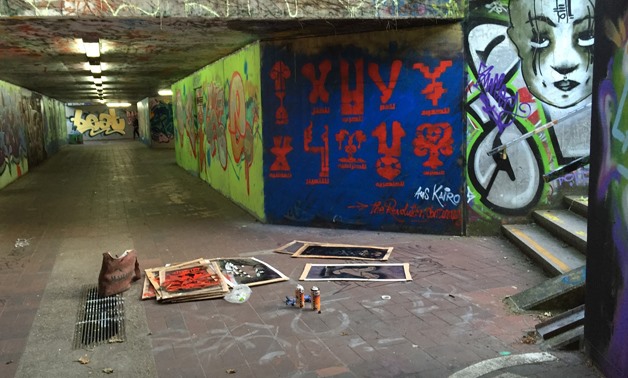
Bahia Shehab street art
Egyptian-Lebanese artist and professor Bahia Shehab talks about graffiti, flowers, the next generation and becoming the first Arab woman to receive the UNESCO Sharjah Prize for Arab Culture.
Bahia Shehab never believed she had it in her to go out and spray paint “no” in the streets of Cairo during the revolution in 2011. After all, she was a mother of two girls, a historian and a professor at the American University in Cairo (AUC).
She also never expected that her graffiti art series “A Thousand Times No” would land her the UNESCO Sharjah Prize for Arab Culture, making her the first Arab woman to ever receive the award. Her project combines calligraphy and graffiti, featuring 1,000 ways to write the word “no” in Arabic, along with drawings symbolizing political and economic injustices as well as personal issues and gender discrimination.
“I would never have imagined myself as a graffiti artist. I had actually just done an anti-vandalism campaign for the Ministry of Antiquities, so it was quite ironic,” Shehab says with a laugh.
In her office at the AUC campus in New Cairo, Shehab recalls that she had never used graffiti as a way of expressing herself before 2011. But the spray can was a tool that was available to her, so she picked it up and began spraying her now-iconic stencils of the word no in Arabic and the blue bra, which came to symbolize the revolution.
“The same way lawyers were helping people out of prison and doctors were helping the wounded, I felt that it was my responsibility as an artist to do the minimum that I could; and that came out as grafitti,” Shehab says.
Some of Shehab’s messages were against violence, creating a new pharaoh, killing, stripping Egyptian women, creating barriers to keep people from demonstrating and gender discrimination.
The Sharjah prize, carrying a monetary value of $60,000 divided between the laureates, was created in 1998 and is awarded annually to two individuals, groups or institutions who have done an outstanding job in spreading the knowledge of Arab culture and art. Shehab, along with French artist eL Seed, were this year’s winners and received their awards in April at the UNESCO headquarters in Paris. During the awards ceremony, UNESCO
Director General Irina Bokova described the laureates’ works as “exemplary of the vitality of Arab culture, its richness and the link it establishes with our cultures by means of openness, creation and optimism.
“It’s an honor to receive the award, because it’s also a validation of the ideas I’ve been promoting. I don’t see myself representing only myself—I never did it for my own personal glory, but I’m proud, because I represent a part of the society that I think needs representing,” beams Shehab.
But even though Shehab represents women and women’s rights, she thinks it is even more important to promote human rights.
In her mind, the two cannot be separated, explaining that she was inspired to develop courses for a graphic design program based on the visuals of the Arab world. She now teaches the program at AUC, graduating around 40 students annually.
“I teach design from an Arab perspective and a lot of the course material is based on social development. For their graduation project, a lot of the students come up with a solution to a problem they have experienced or seen in the society, and they are part of the solution,” says Shehab.
Even though Shehab is busy teaching, she is not done using spray cans to create art. Last year she travelled to nine different cities, from Tokyo to Vancouver, to paint on walls.
“Every message I paint highlights an issue in the Arab society. On a wall on a Greek island I painted a stanza that declared, ‘Those who have no land, have no sea’ and in New York I painted a piece about prisoners in reference to the political prisoners.”
This year, she is travelling to Italy and Norway to paint on walls there. However, her next trip abroad is to Istanbul to set up and open her first solo exhibition called “The Chronicles of Flowers.” Shehab first came up with the idea for the art exhibition when she was bedridden after breaking a knee in 2011.
“My mother flew in from Beirut and every morning she put small flower arrangements next to my bed. I started taking photos of these flowers and a few months later I found out that I had hundreds of these flower photos. Then I worked with the concept of a wooden mashrabia window screen and the question of how knowledge is transferred from one generation to the next,” Shehab explains, pausing to show a video of the exhibition.
Three screens are placed next to each other featuring geometric flower patterns and video sequences of her flower pictures, along with photos of her mother and daughters projected on the screens. “The first screen represents my mother, the next myself and the last one my daughters,” Shehab explains.
The art exhibition is multi-sensory—the audience will be able to smell the flowers while looking at the three screens and flipping through the 300-page book showing the flowers and their scientific name that Shehab also designed.
“I love street art, it’s so simple to explain. You see it, you get it. I don’t have to tell you my life story for it to make sense,” says Shehab. “With gallery art there is a more complex concept behind it; and that’s why I definitely prefer street art.”

Comments
Leave a Comment